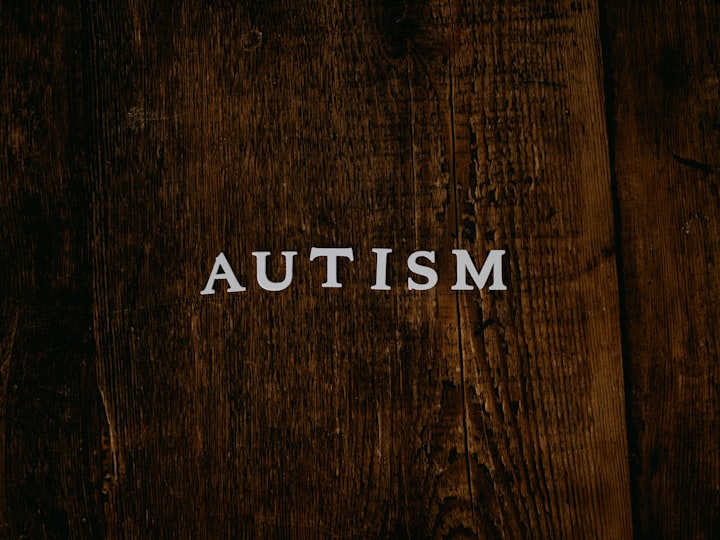How To Write About Characters with Autism Ch. 1
The collective do-and-don’t list written by an autistic 20 year old.

Like any mental disorder, ASD (Autism Spectrum Disorder) has several criteria that someone's behavior is required to match for them to be considered autistic.
No one's experience with any disorder is ever the same, but there are always multiple things about a person that can be analyzed to bring doctors to the eventual conclusion that they have the disorder.
As you write your character, it's up to you to decide whether or not they have been diagnosed before writing. It's also up to you to decide how the criteria are incorporated into your character and how it affects the storyline.
CHAPTER ONE: THE BASES OF AUTISM
Before we get into autism behaviors, we will start with learning about the base that makes autism behaviors what they are, and my analysis, as an autistic person, of how my brain operates.
PART ONE: THE DEFINITION
Autism - (n.) a developmental disorder of variable severity that is characterized by difficulty in social interaction and communication and by restricted or repetitive patterns of thought and behavior.
**NOTE:
Developmental Disorder - (n.) a disorder resulting from abnormal or delayed mental or physical development, or characterized by developmental delay.
PART TWO: THE DSM-5 CRITERIA
Per the DSM-5, autism has two main structures: Communication Deficit and Restrictive & Repetitive Behaviors.
1. Communication Deficit -
cit. cdc.gov Diagnostic Criteria for 299.00 Autism Spectrum Disorder:
"Deficits in social-emotional reciprocity, ranging, for example, from abnormal social approach and failure of normal back-and-forth conversation; to reduced sharing of interests, emotions, or affect; to failure to initiate or respond to social interactions.
Deficits in nonverbal communicative behaviors used for social interaction, ranging, for example, from poorly integrated verbal and nonverbal communication; to abnormalities in eye contact and body language or deficits in understanding and use of gestures; to a total lack of facial expressions and nonverbal communication.
Deficits in developing, maintaining, and understand relationships, ranging, for example, from difficulties adjusting behavior to suit various social contexts; to difficulties in sharing imaginative play or in making friends; to absence of interest in peers."
As you can see, the first definition is very broad and touches on several autism traits straight away:
- Executive Dysfunction - The failure to maintain behaviors that facilitate the attainment of chosen goals.
- Social Unawareness - A genuine lack of understanding of societal standards, structures, and social identities.
- Non-Verbal - No words or speech; a "mode" in individuals that can be verbal who are on the spectrum; a lifestyle for those on the spectrum who do not use speech.
- Stimming - Repetitive fidgeting or movement of the body or objects to maintain focus and stay "present”
(Stimming is done by everyone and isn't limited to the autism community.
- Masking - Mirroring of learned behaviors by watching peers interact "normally."
(Masking is done by everyone and isn't limited to the autism community.)
The above-mentioned traits will be discussed in a later chapter. As will functioning labels and charts from the DSM-5
2. Restrictive and Repetitive Behavior
cit. cdc.gov Diagnostic Criteria for 299.00 Autism Spectrum Disorder:
"Stereotyped or repetitive motor movements, use of objects, or speech (e.g., simple motor stereotypes, lining up toys or flipping objects, echolalia, idiosyncratic phrases).
Insistence on sameness, inflexible adherence to routines, or ritualized patterns of verbal or nonverbal behavior (e.g., extreme distress at small changes, difficulties with transitions, rigid thinking patterns, greeting rituals, need to take same route or eat same food every day).
Highly restricted, fixated interests that are abnormal in intensity or focus (e.g., strong attachment to or preoccupation with unusual objects, excessively circumscribed or perseverative interests).
Hyper- or hyporeactivity to sensory input or unusual interest in sensory aspects of the environment (e.g. apparent indifference to pain/temperature, adverse response to specific sounds or textures, excessive smelling or touching of objects, visual fascination with lights or movement)."
Yet another broad definition touching on very important autism traits:
- Perseverative Thinking - When someone becomes fixated with an idea or topic, leading them to behave in the same ways and say the same things over and over again.
(Can happen to anyone and is not limited to the autism community.)
- Hypersensitivity - A psychological or physical response that is abnormally sensitive.
- Hyposensitivity - A psychological or physical response that is abnormally insensitive.
- Special Interests - A hyper-fixated interest in a particular topic, person, place, or thing beyond the usual amount of knowledge
PART THREE: HOW THE CRITERIA FIT INTO A DIAGNOSIS
Of all the traits I listed, it is possible to have them all and just a few of them, as long as your criteria fall beneath both categories. Males and females with autism tend to be very different and as a result, express their disorders differently.
Males are more likely to be diagnosed with autism and are usually caught up within early childhood.
Females are less likely to be diagnosed with autism and usually are misdiagnosed with ADHD (Attention Deficit Hyperactive Disorder), BPD (Borderline Personality Disorder), or Bipolar Disorder.
This isn't to say that males can't be diagnosed later in life because they can. Females can also be diagnosed earlier in life. It simply depends on their life path and the resources available to them.
In my personal experience, I wasn't diagnosed until I was fifteen and I know several females with autism who weren't diagnosed until their late teen years. So what goes wrong with so many diagnoses? A myriad of things.
1. Lack of Research
While scientists are quick to jump the gun and explain that autism is a burden, they supply the complex disorder with little to any research. Most doctors fail to understand why our minds operate the way they do. As a result, the public knows significantly less about ASD than they should. This brings us to the second reason.
2. Little Public Knowledge of Autism
Depending on when your character is growing up, something preventing them from a diagnosis is little knowledge about autism. When I attended elementary school way back in 2007 - 2010, my teachers mistook a lot of my behavior for ADHD (Attention Deficit Hyperactive Disorder)
While both disorders have similar criteria, I displayed traits like non-verbal behaviors, hypersensitivity to noise, light, and social interactions, and stimming.
Their entire reasoning for thinking I had ADHD was how hyperactive I was during lectures and their lack of control over me, which also points to autism. At some point, they did discover a possibility of autism and gave me ABA Therapy twice a week in second grade, which was probably illegal the more I reflect on it.
3. Masking
Yup, we may even jeopardize a diagnosis on our own. By the ages of seven or eight, children realize what roles they fit in society.
Boys and girls may separate and begin playing in separate cliques. When a child is masking, they're aware that they're different by analyzing their peers and realizing they're different.
Neurotypical children tend to make socially acceptable advances toward each other. As a result, they're more likely to form friendships and create good relationships with their teachers and peer environments.
Children with autism crave the same balance when they realize they can't do the same things on their own. As a result, they may fixate on particular peers and model the same behavior to get by. They may even find a character on television or in a book that they admire and model their behavior too.
This is partially related to another autism trait: executive dysfunction.
FUN FACT: Females with autism are more likely to mask, although males may also mask.
PART FOUR: THE AUTISM WHEEL & SUPPORT NEEDS
When building your character's diagnosis, think about how they interact with the world around them. Do they mask? Were they showing symptoms since they were young, like me? Are they a boy, or a girl? Will they struggle with a misdiagnosis? Where are their support needs? It's all up to you. But keep in mind, that all the criteria should be met.
Traits are dependent on support needs, which are based on what criteria your character meets.
To help visualize that, ASD looks less like a straight line between high and low functioning and more like this:
Maybe they're non-verbal and have higher support needs in the abnormal/flat-speech category.
Perhaps they struggle with executive dysfunction and need a lot of help to get on their feet.
Whichever categories you choose to prioritize for their diagnosis is totally up to you! Just remember, they struggle a little bit in each area. For example, let's use some of my autism traits:
I'm a master at masking. If you met me on the street, you would never suspect I had autism unless you noticed how much I hate making eye contact and the fact I could barely lift my head to meet your eyes. You may also notice my irregular posture.
However, if we're in public, you may notice that I'm watching our surroundings in an attempt to keep up with where I am and prevent myself from getting lost in my thoughts so I can respond to you. Which is a struggle of Sensory Processing.
However, most textures don't bother me and I can wear almost anything, which is also part of Sensory Processing!
Every piece of the base is extremely important for understanding how the rest of the layers of autism work. Never forget that people are diverse and no two experiences are the same.
Just because someone has depression you wouldn't assume they are suicidal.
They may just be very unmotivated and lost with their current affairs. It's the same thing with autism, our disorder just happens to be significantly more complex because it's developmental and affects such a wide scale of people.
Follow along for more!
About the Creator
J.C. Agguire
A 20 year old autistic woman with a knack for writing—she dreams of being a serious author someday.






Comments
There are no comments for this story
Be the first to respond and start the conversation.